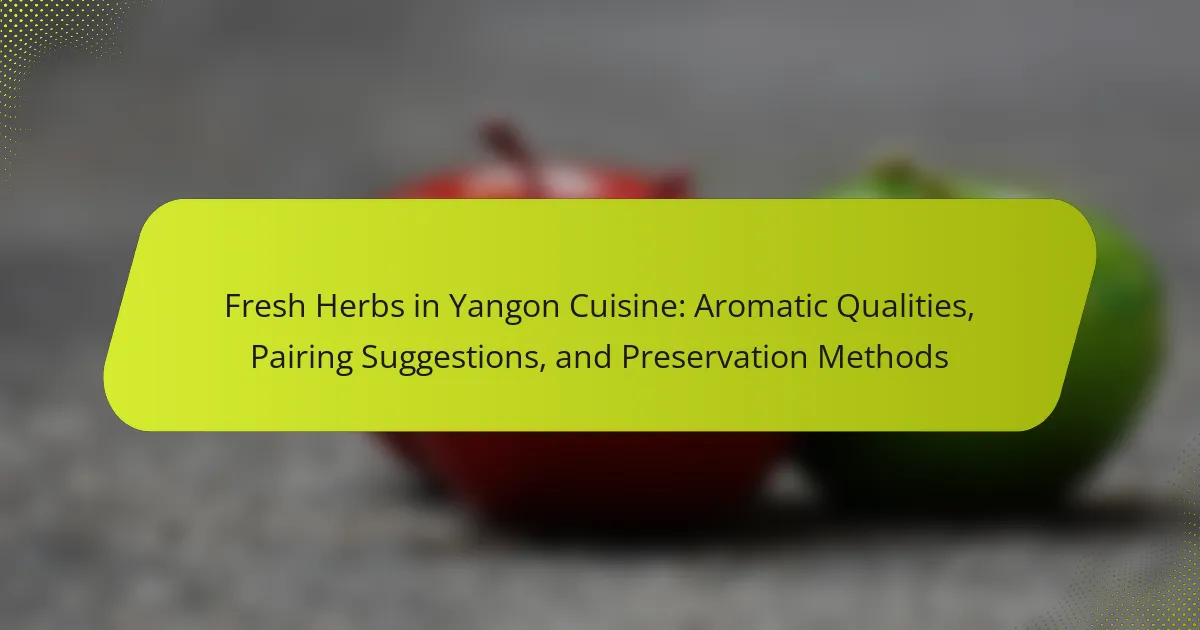Fresh herbs are vital components of Yangon cuisine, enhancing the flavor and aroma of various dishes. Commonly used herbs include cilantro, mint, and basil, which are integral to salads, soups, and curries. These herbs not only elevate taste but also contribute to the visual appeal of meals when used as garnishes. The article explores the best pairing suggestions for these herbs, highlighting how cilantro complements Mohinga, mint enhances salads and grilled meats, and basil adds depth to curries and stir-fries. Additionally, effective preservation methods such as drying, freezing, and oil infusion are discussed to maintain the freshness and flavor of these essential ingredients.

What are Fresh Herbs in Yangon Cuisine?
Fresh herbs in Yangon cuisine are essential ingredients that enhance flavor and aroma. Common fresh herbs include cilantro, mint, and basil. These herbs are often used in salads, soups, and curries. They provide a vibrant taste that complements the dishes. Fresh herbs are typically added at the end of cooking to preserve their flavor. They are also used as garnishes to enhance presentation. The use of fresh herbs is rooted in local culinary traditions. Their availability in markets contributes to their prominence in Yangon cuisine.
How do fresh herbs enhance the flavors in Yangon dishes?
Fresh herbs enhance the flavors in Yangon dishes by adding aromatic qualities and depth. They introduce vibrant, fresh tastes that elevate the overall dish. Common herbs like cilantro and mint contribute unique flavor profiles. Cilantro offers a citrusy note, while mint adds a refreshing touch. These herbs also balance the rich and spicy elements of Yangon cuisine. Their presence can make dishes more complex and layered. Fresh herbs are often used as garnishes, enhancing visual appeal and aroma. The use of herbs is integral to achieving authentic flavors in traditional recipes.
What specific aromatic qualities do these herbs bring to the cuisine?
Fresh herbs in Yangon cuisine provide distinct aromatic qualities that enhance flavor profiles. These herbs, such as cilantro, basil, and mint, contribute fresh, vibrant scents. Cilantro adds a citrusy, slightly peppery aroma. Basil brings a sweet, peppery, and slightly minty fragrance. Mint offers a cool, refreshing scent that brightens dishes. The combination of these aromas creates a complex and inviting sensory experience. These aromatic qualities are essential in balancing flavors and elevating the overall dining experience in Yangon cuisine.
How do the aromatic properties of fresh herbs differ from dried herbs?
Fresh herbs have more volatile aromatic compounds than dried herbs. This results in a stronger and more vibrant aroma when fresh. The drying process diminishes these volatile oils, leading to a less intense fragrance. Fresh herbs often contain higher moisture content, which also contributes to their aromatic profile. For example, basil and cilantro release unique scents when fresh that are not as pronounced when dried. Studies show that fresh herbs can have up to 80% more aromatic compounds compared to their dried counterparts. This difference impacts flavor, making fresh herbs preferable in many culinary applications.
Which fresh herbs are most commonly used in Yangon cuisine?
The fresh herbs most commonly used in Yangon cuisine include cilantro, mint, and basil. Cilantro is often used in salads and soups. It adds a fresh, citrusy flavor. Mint is frequently used in salads and as a garnish. It provides a cooling effect and aromatic qualities. Basil, particularly Thai basil, is popular in various dishes. It imparts a sweet and slightly spicy flavor. These herbs are essential for enhancing the overall taste of Yangon dishes. Their usage reflects the region’s culinary traditions and preferences.
What are the unique attributes of each commonly used herb?
It is not possible to provide unique attributes for each commonly used herb without specifying which herbs are being referenced. Each herb has distinct characteristics that vary widely. For example, basil is known for its sweet aroma and culinary versatility, while cilantro has a fresh, citrusy flavor. However, without a defined list of herbs, a comprehensive answer cannot be given.
How do local conditions influence the types of herbs available?
Local conditions significantly influence the types of herbs available in a region. Factors such as climate, soil type, and altitude determine which herbs can thrive. For instance, warm, humid climates support the growth of tropical herbs like basil and cilantro. Conversely, cooler climates may favor herbs like thyme and rosemary. Soil quality affects nutrient availability, impacting herb growth and flavor. Regions with rich, well-drained soil produce more robust herbs. Additionally, altitude can influence temperature and sunlight exposure, further affecting herb varieties. These local conditions create a diverse array of herbs suited to specific environments.

What are the best pairing suggestions for fresh herbs in Yangon cuisine?
The best pairing suggestions for fresh herbs in Yangon cuisine include cilantro, mint, and basil. Cilantro complements dishes like Mohinga, enhancing the flavor profile. Mint pairs well with salads and grilled meats, providing freshness. Basil, particularly Thai basil, is ideal for curries and stir-fries, adding aromatic depth. These herbs are integral to traditional recipes, enhancing both taste and authenticity. Their unique flavors elevate the overall dining experience in Yangon cuisine.
How can fresh herbs be paired with other ingredients in dishes?
Fresh herbs can enhance dishes by pairing them with complementary ingredients. For example, basil pairs well with tomatoes and mozzarella in salads. Cilantro works effectively with lime and chili in salsas. Mint is often combined with yogurt and cucumber in sauces. Dill complements fish and potatoes beautifully. Thyme can enhance roasted meats and vegetables. Rosemary pairs well with lamb and garlic. Parsley adds freshness to grains and legumes. These combinations leverage the aromatic qualities of herbs, elevating the overall flavor profile of the dish.
What are some traditional pairings that highlight the herbs’ flavors?
Traditional pairings that highlight the flavors of herbs include basil with tomatoes, mint with lamb, and cilantro with lime. Basil enhances the sweetness of tomatoes in dishes like Caprese salad. Mint complements the richness of lamb, often used in Middle Eastern cuisines. Cilantro adds freshness to lime, commonly found in Mexican salsas. These pairings create a balance that accentuates the herbs’ aromatic qualities.
How do herbs complement different proteins and vegetables in Yangon dishes?
Herbs enhance the flavors of proteins and vegetables in Yangon dishes. Common herbs like basil, coriander, and mint add freshness and complexity. These herbs balance rich proteins such as chicken and fish, making dishes more palatable. For instance, coriander pairs well with shrimp, adding a citrusy note. Basil complements beef, providing a fragrant aroma. Additionally, herbs can elevate the taste of vegetables, like adding mint to stir-fried greens. This combination of herbs and ingredients creates a harmonious flavor profile. The use of fresh herbs is a hallmark of Yangon cuisine, showcasing the region’s culinary diversity.
What factors should be considered when pairing herbs with specific cuisines?
When pairing herbs with specific cuisines, consider flavor profiles, cultural traditions, and ingredient compatibility. Flavor profiles dictate whether herbs enhance or clash with the dish. For example, basil complements Italian dishes, while cilantro is prevalent in Mexican cuisine. Cultural traditions influence herb usage, as certain cuisines have established pairings over generations. Ingredient compatibility ensures that herbs work harmoniously with the main components of a dish. For instance, robust herbs like rosemary suit hearty meats, while delicate herbs like dill pair well with fish. Additionally, the seasonality of herbs affects freshness and potency. Using seasonal herbs can elevate a dish’s overall flavor. Thus, considering these factors leads to successful herb pairings in various cuisines.
How does the balance of flavors affect the choice of herbs in dishes?
The balance of flavors significantly influences the choice of herbs in dishes. Different herbs contribute unique flavor profiles that can enhance or counterbalance other ingredients. For instance, basil adds sweetness, while cilantro provides a fresh, citrusy note. The right combination can create harmony in a dish. In Yangon cuisine, balancing salty, sweet, sour, and bitter flavors is crucial. Herbs like mint and lemongrass are often chosen to provide freshness and brightness. This strategic selection ensures that no single flavor overpowers the others. Ultimately, the choice of herbs is guided by their ability to complement the overall flavor balance of the dish.
What role does the seasonality of herbs play in pairing suggestions?
The seasonality of herbs significantly influences pairing suggestions in culinary practices. Fresh herbs are at their peak flavor and potency during specific seasons. For example, basil thrives in warm weather, enhancing dishes like salads and pasta. In contrast, herbs like rosemary and thyme are more robust in cooler months, complementing hearty meals. Seasonal herbs also align with local produce availability, creating harmonious flavor profiles. Pairing seasonal herbs with corresponding ingredients enhances freshness and taste. This practice not only elevates dishes but also supports sustainable cooking by utilizing locally sourced ingredients.

What are effective preservation methods for fresh herbs in Yangon cuisine?
Effective preservation methods for fresh herbs in Yangon cuisine include drying, freezing, and oil infusion. Drying herbs removes moisture, preventing spoilage. This method retains flavor and can last for months. Freezing herbs maintains freshness and aroma. This method is ideal for long-term storage. Oil infusion involves submerging herbs in oil, which preserves their flavor. This method is commonly used for making herb-infused oils. Each method is widely practiced in Yangon to ensure herbs remain flavorful for culinary use.
How can fresh herbs be stored to maintain their flavor and aroma?
Fresh herbs can be stored by wrapping them in a damp paper towel and placing them in a plastic bag. This method helps retain moisture and prevents wilting. Alternatively, herbs can be stored upright in a jar of water, similar to fresh flowers. Covering the herbs loosely with a plastic bag can provide additional humidity. Refrigeration is ideal for most herbs to maintain their flavor and aroma. Some herbs, like basil, prefer room temperature and should not be refrigerated. Proper storage can extend the freshness of herbs for up to two weeks. Research indicates that moisture levels are crucial for preserving herb quality, as dry conditions lead to flavor loss.
What are the best practices for drying fresh herbs?
The best practices for drying fresh herbs include selecting healthy, vibrant herbs and washing them thoroughly. After washing, pat the herbs dry with a clean towel to remove excess moisture. Next, remove any damaged leaves and cut the stems to a manageable length. You can dry herbs using methods such as air drying, using a dehydrator, or an oven. Air drying involves hanging the herbs in small bundles in a warm, dry, and dark place. A dehydrator should be set to a low temperature, around 95°F to 115°F, for optimal results. If using an oven, keep the temperature below 180°F to prevent cooking the herbs. Properly dried herbs should be crumbly and retain their color and aroma. Store dried herbs in airtight containers away from light and moisture to preserve their potency.
How can freezing enhance the longevity of fresh herbs?
Freezing enhances the longevity of fresh herbs by significantly slowing down the degradation process. When herbs are frozen, enzymatic activity that causes spoilage is halted. This preserves their flavor, color, and nutritional content. Research indicates that freezing can maintain the quality of herbs for up to six months. The process also prevents the growth of bacteria and mold, which thrive in fresh herbs. By freezing, users can enjoy the taste of fresh herbs long after their harvest. Properly frozen herbs can retain up to 90% of their original nutrients.
What innovative techniques can be used for preserving fresh herbs?
Innovative techniques for preserving fresh herbs include freezing, drying, and using oil infusions. Freezing herbs retains their flavor and nutrients. Chopping herbs and placing them in ice cube trays with water or oil is effective. Drying herbs through air drying or using a dehydrator preserves their essential oils. Oil infusions involve submerging herbs in oil, which can enhance flavor while extending shelf life. Vacuum sealing can also prevent oxidation and moisture loss. These methods are widely recognized for maintaining the quality of herbs over time.
How do modern preservation methods compare to traditional techniques?
Modern preservation methods are generally more effective and longer-lasting than traditional techniques. While traditional methods like drying and pickling are time-tested, they often result in loss of flavor and nutrients. In contrast, modern techniques such as freeze-drying and vacuum sealing maintain the herbs’ freshness and aromatic qualities. For example, freeze-drying can preserve up to 90% of the original flavor and nutrients. Additionally, modern methods often require less time and labor compared to traditional ones. This efficiency can lead to reduced food waste and better quality in culinary applications. Overall, modern preservation methods provide enhanced benefits over traditional techniques in terms of flavor retention and convenience.
What are the benefits of using oil or vinegar infusions for herb preservation?
Oil or vinegar infusions provide effective preservation for herbs. They extend the shelf life of fresh herbs by preventing spoilage. The oil creates a barrier against air, reducing oxidation. Vinegar, being acidic, inhibits bacterial growth. Both methods enhance flavor, allowing herbs to impart their qualities over time. Studies show that herbs preserved in oil or vinegar retain more essential oils and nutrients. This method is also simple and requires minimal equipment. Overall, infusions are a practical solution for maintaining the aromatic qualities of herbs.
What practical tips can be applied for using fresh herbs in cooking?
Use fresh herbs to enhance flavor in cooking. Chop herbs finely to release their essential oils. Add herbs towards the end of cooking to preserve their flavor. Consider pairing herbs with complementary ingredients for balanced dishes. Store fresh herbs in the refrigerator to maintain freshness. Use a damp paper towel to wrap herbs for better preservation. Experiment with different herbs to discover unique flavor profiles. Remember that some herbs, like basil, can lose flavor when cooked too long.
Fresh herbs are a fundamental component of Yangon cuisine, significantly enhancing flavor and aroma in various dishes. Commonly used herbs include cilantro, mint, and basil, each contributing unique aromatic qualities that elevate the overall dining experience. The article explores how these herbs complement different ingredients, traditional pairings, and the impact of seasonality on herb selection. Additionally, it covers effective preservation methods such as drying, freezing, and oil infusions to maintain the freshness and potency of herbs for culinary use. Overall, the discussion emphasizes the importance of fresh herbs in achieving authentic flavors and enhancing the sensory appeal of Yangon dishes.
